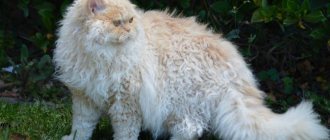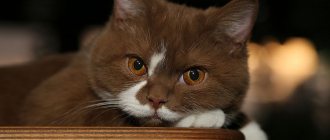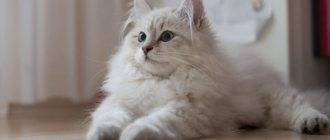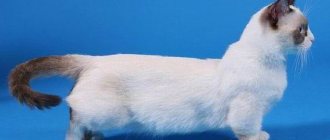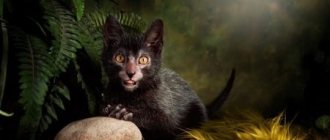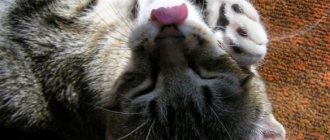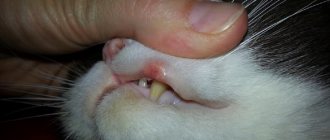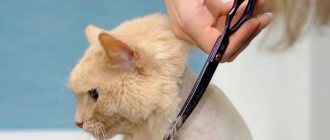Pet owners love to show off the intelligence of their furry companions. Of course, it would be wrong to judge the intelligence of cats by their ability to learn. Pets lack motivation due to the need to survive, which reduces their learning ability. However, they are certainly characterized by intelligence and adaptability. An incredibly inventive and self-sufficient species has been able to survive in different living conditions for thousands of years. Even domestic cats demonstrate a cunning, strong-willed and versatile character. And among them it is not so easy to determine the smartest cat breed.
Cat intelligence: features
Furry pets are one of the most intelligent creatures in the animal kingdom. Unfortunately, their abilities are studied to a lesser extent than those of dogs. And we get most of the information from the history of the owners, as well as from the few studies developed specifically for these animals.
Intelligence is defined as the ability to learn from experience, retain that knowledge, and use it to solve problems in a new environment. Intelligence is determined by the functioning of the brain, and a significant role is played not by its size, but by the folding of the surface (the number of convolutions) and structure. These factors are considered basic in assessing intelligence. The structure of the cat's brain and its surface are 90 percent similar to those of humans. In humans, the cerebral cortex, the area of the brain that controls thinking and rational decision making, contains between 21 and 26 billion neurons, or nerve cells. Cats have 300 million neurons compared to dogs' 160 million neurons. This is what is considered the basis of cat intelligence.
The cerebral cortex controls not only the higher functions of rational thinking, but also problem solving. This is also the storage area for short-term and long-term memory. For comparison: a person remembers “what”, “where” and “when” he experienced. New research shows that cats can remember and use "what" and "where" information learned from experience.
Just like people, cats learn by watching and doing. Examples include opening doors, ringing a bell, and turning on lights. This is procedural memory, and cats are good at it. Research shows that these memories last 10 years or more. Cats associate memories of an event or place with the emotions they felt. They will remember experiencing traumatic stress, pain, or fear in the vet's room. Luckily, they also remember the positive experiences.
Curious cat
Criteria for evaluation
Cat intelligence has always been difficult to assess. The researchers used different methods. Intelligence has been measured in a variety of ways, from counting brain cells to testing how easily animals learn. But despite this, large gaps in knowledge still remain.
Most current research focuses on one of the following categories:
- Object Persistence and Memory: Object permanence usually means that animals can understand that an object still exists even though it may be out of sight. Cats also perform well on short-term memory tests (up to 30 seconds).
- Physical cause and effect: understanding that if I do this, something else will follow.
- Understanding number and time: The experiment showed that cats can distinguish numbers, they are just indifferent to them in most cases. On the other hand, any owner who has ever been a few minutes late with feeding knows that these animals have an internal clock.
- Human speech perception: Cats pay attention to their humans, especially when it comes to rewards.
- Communication: How many sounds does your cat make? Can you tell what they want? No one will deny that his pet can be very talkative.
- Attachment to people. Felines are often compared to dogs, which are considered the standard of affection for people. However, recent research has shown that cats show affection in different ways. For example, they are known to calm a person who is anxious or stressed by spending time with them and purring.
- Personality characteristics: Many of these factors depend on the individual characteristics of the cat. Some breeds are believed to rank higher in intelligence, but there is no evidence to support such claims.
Cats learn to call
Innate ability or acquired skill
Many of the cat's remarkable mental and physical abilities are considered instinctive. Moreover, they do not depend on whether the animal is purebred or not. However, just as humans are born with innate communication skills but need time to master speech, cats improve many of their innate abilities through practice. The widely held belief that they learn through observation and imitation of their mother or other cats is now being questioned. Cats learn, but not in the same way as humans or dogs; they have a special kind of intelligence.
Once a skill is mastered, even if it happens by accident or trial and error, most of the knowledge is retained for life thanks to the cat's excellent memory. Even hunting methods buried under the inaction of a well-fed domestic cat will be easily remembered if the cat for some reason is forced to provide for itself.
When frightened, the cat will retain very unpleasant memories of the incident, which it considers threatening. All it takes is one face-to-face encounter with a growling dog to convince your cat that it is best to avoid all dogs. However, positive experiences are also easily retained and recalled, especially if they involve food or play.
As any cat owner knows, they respond well to familiar sounds, such as opening a can of food, the rustling of bags of dry food, or the noise of a favorite toy. Many of them also have the uncanny ability to know breakfast times.
The cat teacher is standing against a chalkboard. He teaches his pupils mathematics.
Dimensions of a cat's brain
Although the brain of a domestic cat is quite complex in structure. The size does not exceed 5-6 cm. The weight of the brain is 1.2-0.5% of body weight, that is, only 30 grams (considering that the average cat weighs 2.5-6.5 kg). This is 2 times less than the same percentage in humans. It is generally believed that dogs have larger brains. The comparison in this case is not entirely appropriate, since it must be taken into account that dogs weigh more than cats, and a dog’s head is larger in size. A 2009 study published in the journal NewScientist found that a cat's brain makes up a larger percentage of its body weight than a dog's. Because of this, the cat consumes more blood - up to 20%.
Who is smarter, males or females?
It is impossible to say with certainty that cats are more intelligent than cats. The difference may be due to the personality traits and skills they acquired in childhood. In humans, boys initially develop slightly slower than girls. The same goes for dogs, cats and many other mammals. When taking home a small pet, many people find that females learn faster and are easier to train. Although this is not a problem of intelligence. It's a matter of maturity.
Moreover, according to many years of observations, the sex of the animal does not matter. Only the individual characteristics of a particular individual play a role.
Hepatitis in cats
Most often, cats experience not just hepatitis, but cholangiohepatitis, that is, inflammation of the liver involving the bile ducts and gallbladder.
There are many reasons for the development of cholangiohepatitis: long-term loss of appetite as a result of stress or another disease, impaired absorption of proteins in the gastrointestinal tract, obesity, etc.
In addition, due to the unusual anatomical connection between the common bile duct and the main pancreatic duct in cats, bacteria or digestive enzymes from the duodenum or pancreas are refluxed, which leads to the development of bacterial or sterile hepatitis or cholangiohepatitis.
Clinical signs in most adult cats are the same and not specific: lethargy, drowsiness, lack of appetite, progressive weight loss. Less common are chronic vomiting, diarrhea, fever, abdominal effusion, and signs of damage to the central nervous system. Hepatic encephalopathy in cats most often manifests itself as depression and drooling.
Specific signs of liver inflammation: jaundice, enlarged liver. Similar clinical signs may result from non-inflammatory liver diseases such as lipidosis, bile duct obstruction, chronic viral infections such as feline viral peritonitis, and cancer.
The diagnosis is made based on a combination of anamnestic data, blood tests, including infections, and ultrasound results. In many cases, a final diagnosis is possible only after histological examination of a biopsy of liver tissue.
In the treatment of hepatitis, antibiotic therapy and choleretic drugs play an important role. anti-inflammatory drugs, as well as nonspecific treatment aimed at eliminating dehydration, removing toxic substances, etc.
Leave feedback. Hepatitis in cats
Rating of the smartest cat breeds
The smartest breeds tend to be the most playful. They prefer to spend time with people, try to communicate and enjoy learning new toys. They even study well. However, they may also be more likely to get into trouble than others. If you don't train them regularly through activity and play, these curious creatures may try to entertain themselves with more dangerous games. Top 10 smartest breeds:
- Abyssinian.
- Scottish lop-eared.
- Siamese.
- Burmese.
- Japanese Bobtail.
- Cornish Rex.
- Orientals.
- Norwegian forest.
- Balinese cat.
- Russian blue.
Abyssinian cat
Abyssinian cat
This is the case when no one has any doubts about which cat breed is called the smartest. If the best way to learn is to play, Abyssinians are among the best students. This is one of those breeds that can learn to play with small objects and will enjoy doing so. They are excellent at jumping and climbing. If you don't have a ceiling-length cat tree, Abyssinian cats will make one for themselves from a bookcase, curtain, or anything else they can climb up to the ceiling.
Abyssinians are also very curious, and if something catches your attention, they may try to investigate it. They love to be the center of attention and require constant presence.
Oriental cat
Oriental
The character of this oriental cat is almost identical to the Siamese. Common traits are high intelligence, affectionate nature and a penchant for communication. These chatty creatures often greet their owners at the door and tell them about their day. They also have a way of following those around them, and many show strong loyalty to one person, sometimes even refusing to have close contact with other family members. These are also the smartest cats in the world. Playful and energetic, Orientals are graceful athletes who love to jump from high places and run around the house.
British cat
British
The British Shorthair is a calm, independent creature. Confident, although somewhat reserved in relationships with new people, she is undemanding, affectionate and loyal. This is not the most active breed, which also does not like to sit on laps. However, they love to sit next to their favorite people or at their feet.
Intelligent, trainable, patient and calm in nature, British Shorthairs are often featured in films and television because they are easy to work with. Their gentle temperament makes them good with children and other animals.
Bengals
Bengal cat
The popularity of these leopard beauties is also explained by their intelligence, special character and unique appearance. They rightfully occupy a place in this ranking. Bengal cats are excellent at learning various tricks. This can lead to trouble, as Bengal cats have a tendency to press switches, play with electronics, and even do minor mischief.
Bengals love water and will follow you into the bath or shower if they can. But their love of water and dexterous paws make them a natural disaster for fish in aquariums. Bengals love to climb, so they definitely need a cat tree if you don't want to end up with holey curtains.
Norwegian forest
Norwegian forest
The Norwegian Forest Cat has a pleasant, friendly, easy-going character. These affectionate creatures love to communicate and purr loudly. Tolerant, sociable, intelligent, affectionate and quick-tempered, the Norwegian Forest usually gets along well with children and other pets. This breed is active and playful, making them fun companions for children. They also love to explore high places. They are quiet, like Siamese, but are included in the list of the most intelligent breeds.
Recommendations for education
A cat's natural behavior and intelligence do not require much training when they are kept in a comfortable environment. They don't have to hunt for food and are not chased. But developing skills and intelligence improves their brain function, preventing the age-related decline in brain function that occurs just like in humans.
The best way to develop your pet's intelligence is through games.
Food puzzles
The name of the game speaks for itself. The pet will have to work harder before he receives the reward. This is also due to their natural hunting instinct.
You can buy ready-made toys or make your own. For this, a paper towel or toilet paper roll is suitable, in which you need to cut several holes on the side. Then pour treats in there and close the holes at the ends. The cat will have to tinker a little to find a way to make the treat fall out. You can also hide food in different places so your pet can find it.
Cat food puzzles
Feather on a rope
It turns out that even an ordinary teasing toy helps a cat become smarter. The animal has to constantly solve the problem: how to catch this feather. This makes him think while burning off his cat energy.
Games with water. Fill a sink or large bowl and add a few colorful marbles. It is best if the animal tries to pull the balls out of the water. You can also add some ping pong balls or other floating toys to float on top to make it more of a challenge.
Hide and seek
Any smart cat loves hide and seek because this game allows you to use your hunting instincts. They also love to hide in small, cozy spaces - and any owner knows how much their pet loves boxes.
To teach an animal to play hide and seek, you must remind it that it is a game so that the pet does not worry about you being missing. So keep calling so that he can hear your voice. Start with a few minutes at a time. The animal will very quickly understand the rules of the game. When you "find" each other, make sure you make a big deal out of it so that your pet understands that he is being rewarded for his intelligence.
Sense organs
Through the senses, the animal receives basic information about the world around it. As you know, cats have very sharp eyesight and hearing. They can see even in the dark and are able to hear sounds that humans cannot hear.
A description of the anatomical structure of the organs of vision and hearing is important not only in order to get to know your pet better, but also to recognize the presence of pathological changes and know how to help your pet.
Eyes
Visible part of the eye:
- upper eyelid;
- lower eyelid;
- third eyelid;
- Iris;
- sclera;
- pupil.
Cats have relatively large eyes. Cats have stereoscopic vision. This means that they can perceive size, shape and judge the distance to a certain object. Also, cats can see the world around them not only in front of them, but also from the side. Their eyes are capable of capturing images within a range of 205 degrees around them.
Cats' eyes glow in the dark due to the ability of this organ to accumulate rays that enter the eyes during daylight hours. They cannot see in complete and utter darkness. But even a minimal amount of light entering the room allows them to clearly distinguish objects due to the reflection of light from the surface of objects.
© shutterstock One of the features of cats' eyes is the presence of a third eyelid. This membrane serves as protection against foreign objects entering the cornea. Usually the third eyelid is not visible. It can be noticed in those moments when the animal has just woken up. If it is visually noticeable all the time, or even covers part of the eye, this is a signal about the presence of some pathology in the body.
Ears
A cat's ears are made up of these parts::
- ear canal;
- eardrum;
- middle ear bone;
- vestibular apparatus;
- snail;
- auditory nerve.
Cats have the ability to perceive sounds over a wide range. The physiology of a cat and the structure of its ear allows it to hear high-frequency sounds that are inaccessible to human hearing. A cat can hear about 100 different sounds, while for a person this number is limited to fifty.
There are about 30 muscles around and on the ears that are responsible for movement in this area. Attentive owners notice the cat's ability to move its ears in different directions.
Cat owners should pay extra attention to the structural features of the ear. Your pet should have its ears checked and cleaned regularly. Due to the rather complex structure of the ear, one can often miss the presence of various inflammatory processes and the presence of ear mites.
Structure of the National Assembly and provoking factors
The basis is created by neuron cells. When neurons come into contact, reflex circuits are formed through which nerve impulses pass.
- CNS (brain, spinal cord).
- Peripheral (cranial and spinal nerves connecting the central trunk with receptors of tissues and organs).
Factors that can provoke a nervous system disorder include anything that changes the animal’s usual life.
- change of owner or place of residence;
- riding public (personal) transport;
- visit to the veterinary clinic;
- abrupt transition from one food to another;
- weaning from the mother cat;
- holidays (guests, fireworks, music).
A special place is given to the physical ailments of the cat, in which it experiences pain and discomfort. This also includes veterinary manipulations associated with “improving” appearance, or with preventive methods (castration, sterilization, declawing, etc.).
Emotional stress causes the development of deep neuroses. Although this is not a prerequisite, cats, just like people, have individual characteristics. Some react inadequately to moving the tray, while others are not bothered by loud music in the room, washing, or long trips in the car.
The breeder’s task is to know how sensitive their pet is and to prevent unnecessary worries!

